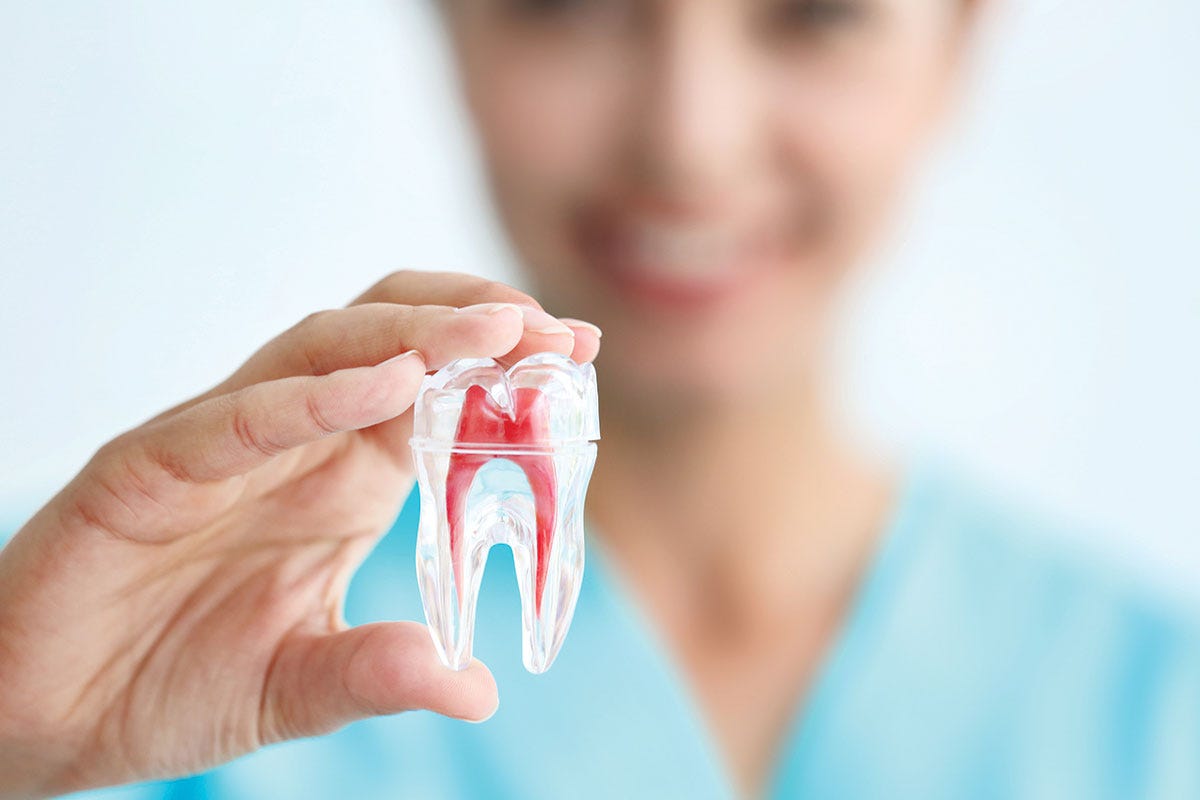What are root cavities?
Root cavities affect the tooth’s hidden root; however, symptoms may occasionally be seen where the tooth and gums meet. When the gums have receded, they will most likely appear. This may occur from brushing too vigorously or even from gum disease.
Tooth decay arises from the production of acids by oral bacteria that erode the tooth enamel. Although most people refer to the holes that result in damaged teeth as “cavities,” dentists refer to the damage as “caries.”
Any surface of the tooth, including the root, the smooth, flat sides, and the biting surface, is susceptible to decay. By definition, cavities that impact the root are called root cavities.
What causes root cavities?
All cavities, including root cavities, are usually the result of dental decay. The process happens gradually, beginning with the formation of a sticky substance on your teeth called plaque, which is caused by oral bacteria that feed on sugar and carbohydrates from the food you consume.
The acid in the plaque can start to erode away at the enamel surface of your teeth and cause the plaque to solidify into tartar.
Bacteria can work their way down into the tiny pores in the enamel to reach the dentin layer of your tooth. If left unchecked, the bacteria have the potential to go all the way to the tooth’s centre, where the nerve is found.
Because it’s more difficult to keep your back teeth clean, dental decay generally tends to affect them more frequently. Additionally, studies reveal that cavities involving damage to the enamel on other surfaces of teeth typically grow twice as quickly as cavities on root surfaces. Because of this, it is essential to act quickly to limit the harm.
Signs of tooth root cavity
By definition, a root cavity occurs on the tooth root; therefore, you probably won’t be able to see it if you look in the mirror or open your mouth to look at your mouth. However, you may have certain warning symptoms, such as tooth discomfort or increased sensitivity, especially to heat or cold.

Additionally, it’s critical to consult a dentist if you observe that your gums are receding, as this is frequently the initial stage of root cavities. In the absence of gum coating, the roots may be more susceptible to rot and germs.
Who Is at Risk for Root Cavities?
Although everyone can have dental cavities, the risk is significantly higher for the elderly. In fact, studies indicate that the risk of having root cavities peaks at age 70. This is because a disorder called periodontal support loss, which is a deterioration of the tissues supporting the teeth, is more common in the elderly.
These tissues may progressively pull away from the teeth over time. Even a portion of the root may occasionally be seen. Cavities and inflammation can result from bacteria infiltrating the tissues. Additionally, teeth might fall loose.
In addition, diabetes and metabolic syndrome are more common in the elderly, which increases the risk of gum inflammation and the subsequent development of periodontal disease.
Smoking and poor oral hygiene are two more factors that might increase your chance of getting periodontitis, according to a 2019 systematic review of studies on root caries.
Consequences of getting root cavities
You do need to get treated for root cavities since they might cause complications. In actuality, you should get treatment right away since the tooth decay that led to your cavity might worsen and spread.
The pulp, or central tissues, of your tooth may become infected with decay. In such a case, a root canal may be necessary to extract the diseased or dead pulp, clear out all of the tiny canals in your tooth, and seal it.
Treatment for root cavities
Therapy for a root cavity shouldn’t differ significantly from therapy for other types of cavities unless you require a root canal. A dentist will extract the decaying portion of the tooth and replace it with a filling, which can be composed of different materials.
Nonetheless, the dentist could advise a root canal if the damage is really extensive. In the event that you have a root canal, a crown could be placed on the tooth afterwards. Crowns can strengthen the tooth that remains after being used to cover substantial damage to teeth.
How to avoid getting root cavities
Preventive measures are the best kind of therapy. Maintaining proper dental hygiene can lower your risk of tooth decay, which includes root cavities.
One highly useful tool in the fight against cavities and tooth disease is fluoride. Professional fluoride treatments and self-applied fluoride treatments, such as a daily fluoride mouth rinse, can be extremely helpful in preventing root cavities, according to a 2020 comprehensive review of studies.
Additionally, you want to wash your teeth twice a day after eating or drinking fluoridated toothpaste.
Here are a few more strategies to avoid dental cavities:
- Regularly floss your teeth.
- Sip fluoridated water.
- Chew on sugarless gum containing xylitol, which may help lessen oral germs that cause tooth decay, according to a study.
- See a dentist on a regular basis for cleanings and examinations.
Summary
Before you know it, you may have root cavities. Since you have a higher chance of getting root cavities overall as you age, you should pay more attention to them.
In fact, see a dentist to find the best course of action for expert checkups and preventative treatments if you know you have a higher than average chance of getting root cavities. This will help to lower your risk and catch any issues early on.
Answers to Common Questions (FAQs)
- Is it possible to avoid cavity roots just by brushing regularly?
Brushing is important, but for cavity root prevention, a comprehensive strategy that also includes flossing and a healthy diet is necessary.
- Are older people more likely to have hollow roots?
While ageing can raise the risk, poor dental hygiene can cause cavity roots in people of all ages.
- Does receiving a root canal hurt?
Anaesthesia and contemporary methods make root canal treatment a somewhat pleasant process.
- Can tooth loss result from cavity roots?
Cavity roots can indeed spread to the point of tooth loss if treatment is not received.
- How frequently should I have dental exams to find cavity roots early on?
It is advised to get dental exams every six months to guarantee early diagnosis and treatment.

